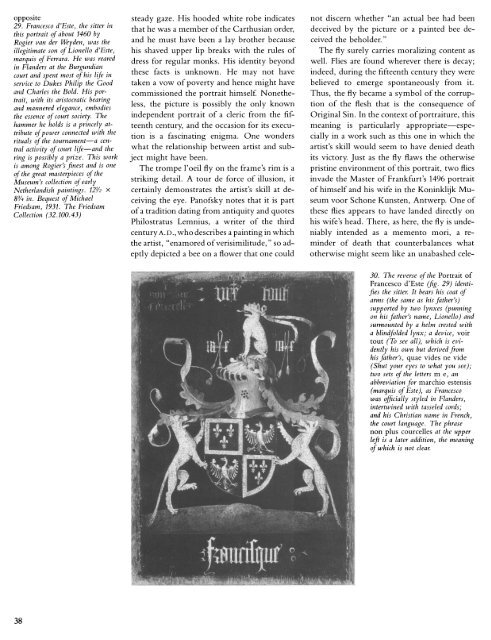Early Flemish Portraits 1425-1525: The Metropolitan Museum of Art ...
Early Flemish Portraits 1425-1525: The Metropolitan Museum of Art ...
Early Flemish Portraits 1425-1525: The Metropolitan Museum of Art ...
Create successful ePaper yourself
Turn your PDF publications into a flip-book with our unique Google optimized e-Paper software.
opposite<br />
29. Francesco d'Este, the sitter in<br />
this portrait <strong>of</strong> about 1460 by<br />
Rogier van der Weyden, was the<br />
illegitimate son <strong>of</strong> Lionello d'Este,<br />
marquis <strong>of</strong> Ferrara. He was reared<br />
in Flanders at the Burgundian<br />
court and spent most <strong>of</strong> his life in<br />
service to Dukes Philip the Good<br />
and Charles the Bold. His portrait,<br />
with its aristocratic bearing<br />
and mannered elegance, embodies<br />
the essence <strong>of</strong> court society. <strong>The</strong><br />
hammer he holds is a princely at-<br />
tribute <strong>of</strong> power connected with the<br />
rituals <strong>of</strong> the tournament-a central<br />
activity <strong>of</strong> court life-and the<br />
ring is possibly a prize. This work<br />
is among Rogier's finest and is one<br />
<strong>of</strong> the great masterpieces <strong>of</strong> the<br />
<strong>Museum</strong>'s collection <strong>of</strong> early<br />
Netherlandish paintings. 12/2 x<br />
83/4 in. Bequest <strong>of</strong> Michael<br />
Friedsam, 1931. <strong>The</strong> Friedsam<br />
Collection (32.100.43)<br />
steady gaze. His hooded white robe indicates<br />
that he was a member <strong>of</strong> the Carthusian order,<br />
and he must have been a lay brother because<br />
his shaved upper lip breaks with the rules <strong>of</strong><br />
dress for regular monks. His identity beyond<br />
these facts is unknown. He may not have<br />
taken a vow <strong>of</strong> poverty and hence might have<br />
commissioned the portrait himself Nonetheless,<br />
the picture is possibly the only known<br />
independent portrait <strong>of</strong> a cleric from the fifteenth<br />
century, and the occasion for its execution<br />
is a fascinating enigma. One wonders<br />
what the relationship between artist and subject<br />
might have been.<br />
<strong>The</strong> trompe l'oeil fly on the frame's rim is a<br />
striking detail. A tour de force <strong>of</strong> illusion, it<br />
certainly demonstrates the artist's skill at deceiving<br />
the eye. Pan<strong>of</strong>sky notes that it is part<br />
<strong>of</strong> a tradition dating from antiquity and quotes<br />
Philostratus Lemnius, a writer <strong>of</strong> the third<br />
century A. D., who describes a painting in which<br />
the artist, "enamored <strong>of</strong> verisimilitude," so adeptly<br />
depicted a bee on a flower that one could<br />
not discern whether "an actual bee had been<br />
deceived by the picture or a painted bee deceived<br />
the beholder."<br />
<strong>The</strong> fly surely carries moralizing content as<br />
well. Flies are found wherever there is decay;<br />
indeed, during the fifteenth century they were<br />
believed to emerge spontaneously from it.<br />
Thus, the fly became a symbol <strong>of</strong> the corruption<br />
<strong>of</strong> the flesh that is the consequence <strong>of</strong><br />
Original Sin. In the context <strong>of</strong> portraiture, this<br />
meaning is particularly appropriate-especially<br />
in a work such as this one in which the<br />
artist's skill would seem to have denied death<br />
its victory. Just as the fly flaws the otherwise<br />
pristine environment <strong>of</strong> this portrait, two flies<br />
invade the Master <strong>of</strong> Frankfurt's 1496 portrait<br />
<strong>of</strong> himself and his wife in the Koninklijk Mu-<br />
seum voor Schone Kunsten, Antwerp. One <strong>of</strong><br />
these flies appears to have landed directly on<br />
his wife's head. <strong>The</strong>re, as here, the fly is undeniably<br />
intended as a memento mori, a reminder<br />
<strong>of</strong> death that counterbalances what<br />
otherwise might seem like an unabashed cele-<br />
30. <strong>The</strong> reverse <strong>of</strong> the Portrait <strong>of</strong><br />
Francesco d'Este (fig. 29) identifies<br />
the sitter. It bears his coat <strong>of</strong><br />
arms (the same as his father's)<br />
supported by two lynxes (punning<br />
on his father's name, Lionello) and<br />
surmounted by a helm crested with<br />
a blindfolded lynx; a device, voir<br />
tout (To see all), which is evidently<br />
his own but derivedfrom<br />
hisfather's, quae vides ne vide<br />
(Shut your eyes to what you see);<br />
two sets <strong>of</strong> the letters m e, an<br />
abbreviation for marchio estensis<br />
(marquis <strong>of</strong> Este), as Francesco<br />
was <strong>of</strong>ficially styled in Flanders,<br />
intertwined with tasseled cords;<br />
and his Christian name in French,<br />
the court language. <strong>The</strong> phrase<br />
non plus courcelles at the upper<br />
left is a later addition, the meaning<br />
<strong>of</strong> which is not clear.

















